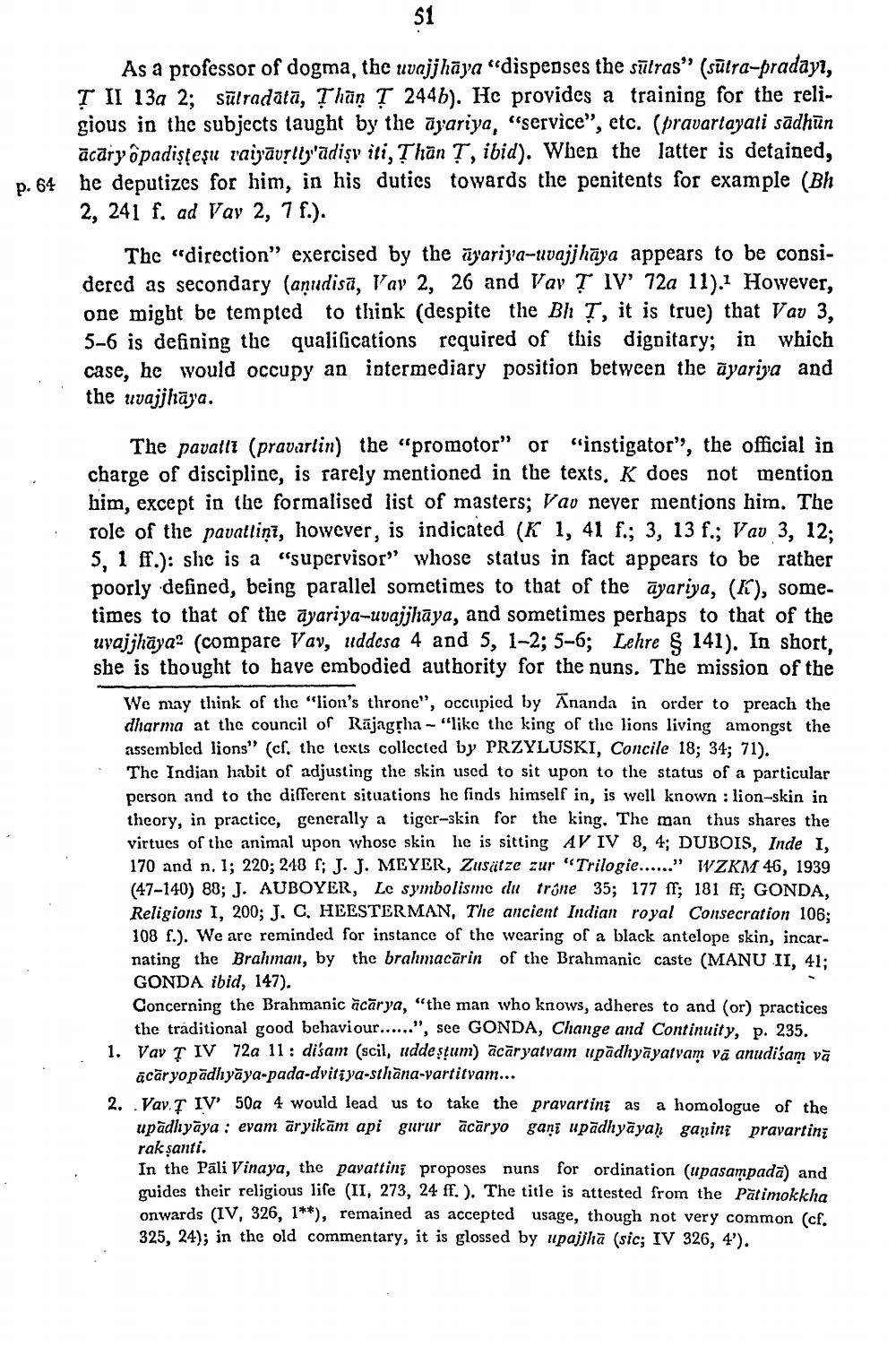________________
As a professor of dogma, the uvajjhāya "dispeoses the sūtras” (sūtra-pradayı, Ţ II 13a 2; sülradatā, Thân ] 2446). He provides a training for the religious in the subjects taught by the āyariya, "service", etc. (pravartayati sādhūn ācāryôpadişteşu vairāvrlig'adişu iti, Thân ?, ibid). When the latter is detained, he deputizes for him, in his duties towards the penitents for example (Bh 2, 241 f. ad Vay 2, 7 f.).
Thc “direction" exercised by the āyariya-uvajjhāya appears to be considered as secondary (aņudisā, Vav 2, 26 and Vav T IV 72a 11). However, one might be tempted to think (despite the Bh ?, it is true) that Vav 3, 5-6 is defining the qualifications required of this dignitary; in which case, he would occupy an intermediary position between the āyariya and the uvajjliāya.
The pavaltı (pravartin) the "promotor" or "instigator”, the official in charge of discipline, is rarely mentioned in the texts. K does not mention him, except in the formalised list of masters; Vav never mentions him. The role of the pavatliņi, however, is indicated (K 1, 41 f.; 3, 13 f.; Vav 3, 12; 5, 1 ff.): she is a "supervisor” whose status in fact appears to be rather poorly defined, being parallel sometimes to that of the āyariya, (K), sometimes to that of the ayariya-uvajjhāya, and sometimes perhaps to that of the uvajjhāya2 (compare Vav, uddesa 4 and 5, 1-2; 5-6; Lehre § 141). In short, she is thought to have embodied authority for the nuns. The mission of the
We may think of the "lion's throne", occupied by Ananda in order to preach the dharma at the council of Rājagpha - "like the king of the lions living amongst the assembled lions" (cf. the texts collected by PRZYLUSKI, Concile 18; 34; 71). The Indian habit of adjusting the skin used to sit upon to the status of a particular person and to the different situations he finds himself in, is well known : lion-skin in theory, in practice, generally a tiger-skin for the king. The man thus shares the virtues of the animal upon whose skin lie is sitting AV IV 8, 4; DUBOIS, Inde 1, 170 and n. 1; 220; 248 f; J. J. MEYER, Zusätze zur "Trilogie......" WZKM 46, 1939 (47–140) 88; J. AUBOYER, Lc symbolisme du trine 35; 177 ff; 181 ff; GONDA, Religions I, 200; J. C. HEESTERMAN, The ancient Indian royal Consecration 106; 108 f.). We are reminded for instance of the wearing of a black antelope skin, incarnating the Brahman, by the bralmacārin of the Brahmanic caste (MANU II, 41; GONDA ibid, 147). Concerning the Brahmanic acārya, "the man who knows, adheres to and (or) practices
the traditional good behaviour......", see GONDA, Change and Continuity, p. 235. 1. Vav T IV 72a 11 : disam (scil, udde sțum) acāryatvam upādhyāyalvam vă anudi'sam vă
acaryopādhyāya-pada-dvitiya-sthāna-vartitvam... 2.Vay. T IV 50a 4 would lead us to take the pravartini as a homologue of the
upādhyāya : evam äryikām api gurur ācāryo gani upadhyāyah ganini pravartini rak şanti. In the Pali Vinaya, the pavattini proposes nuns for ordination (upasampada) and guides their religious life (II, 273, 24 ff.). The title is attested from the Pātimokkha onwards (IV, 326, 1**), remained as accepted usage, though not very common (cf. 325, 24); in the old commentary, it is glossed by upajjhā (sic; IV 326, 4').




